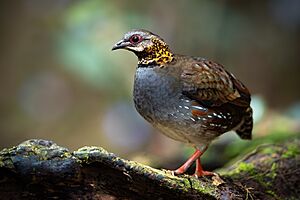Rufous-throated partridge facts for kids
Quick facts for kids Rufous-throated partridge |
|
|---|---|
 |
|
| Photograph taken near Da Lat in Vietnam | |
| Conservation status | |
| Scientific classification | |
| Genus: |
Arborophila
|
| Species: |
rufogularis
|
| Synonyms | |
|
Arboricola rufogularis Blyth, 1849 (protonym) |
|
The rufous-throated partridge (Arborophila rufogularis) is a type of bird that belongs to the Phasianidae family. You can find these birds living in mountain forests in India and other parts of Southeast Asia. The International Union for Conservation of Nature (IUCN) says this bird is a "least-concern species." This means it's not in danger of disappearing right now.
Contents
About the Rufous-throated Partridge
The rufous-throated partridge was first officially described in 1849. An English zoologist named Edward Blyth gave it its scientific name. He studied birds from the Darjeeling district in eastern India. He called it Arboricola rufogularis. The name rufogularis comes from two Latin words: rufus meaning "red" and gularis meaning "throated."
Today, the rufous-throated partridge is one of 19 types of partridges in the genus Arborophila. This group was first named by Brian Hodgson in 1837.
Different Types of Rufous-throated Partridges
There are six known types, or subspecies, of the rufous-throated partridge:
- A. r. annamensis (Robinson & Kloss, 1919) - Found in south-central Vietnam.
- A. r. euroa (Bangs & Phillips J.C., 1914) - Lives in southeastern Yunnan (China) and northern Laos.
- A. r. guttata (Delacour & Jabouille, 1928) - Found in central Vietnam and central Laos.
- A. r. intermedia (Blyth, 1849) - Ranges from northeastern India to northern Myanmar.
- A. r. rufogularis (Blyth,1849) - Lives in northeastern India, Nepal, Bhutan, and southeastern Tibet.
- A. r. tickelli (Hume,1880) - Found in eastern Myanmar, Thailand, and southwestern Laos.
What They Look Like
The rufous-throated partridge is about 26–29 cm (10–11 in) long. That's about the length of a ruler!
- Males usually weigh between 325–430 g (11.5–15.2 oz).
- Females are a bit lighter, weighing 261–386 g (9.2–13.6 oz).
Males have a grey forehead. The top of their head and the back of their neck are olive-brown with black spots. They have white stripes above their eyes and white marks near their mouth. Their throat and the sides of their neck are orange-red with black speckles. Their chest and sides are blue-grey, and their belly is whitish. The lower part of their body is brownish. Their back and wings are olive-brown. Their wings also have bands of chestnut, black, and grey.
Their beak is dark brown or black, and their legs are pink or red. Female partridges look very similar to males. Young birds are not as brightly colored. Their heads and sides have wavy brown and black patterns. Different subspecies can have slightly different patterns on their throats.
Where They Live and Their Home
You can find the rufous-throated partridge in many countries, including Bangladesh, Bhutan, China, India, Laos, Myanmar, Nepal, Thailand, and Vietnam.
They live in montane forests, which are forests found in mountains. They usually prefer to live at high places, between 1,800–3,000 metres (5,900–9,800 ft) above sea level. They especially like oak forests that have laurel and rhododendron trees.
How They Behave and Live
These partridges often feed in groups of five to ten birds. They eat different things like seeds, young plant shoots, berries, insects, and snails.
If they get scared, they will either run away or fly. Sometimes, they fly up into tree branches, much like some thrushes do. When a group of these birds sleeps, they gather closely together in trees, similar to how babblers sleep.
Reproduction and Life Cycle
Rufous-throated partridges lay eggs from April to July in India, and from February to May in China. The male bird builds a simple nest, which is just a shallow dip in the ground. He makes it in bamboo patches, undergrowth in the forest, or near water. The nest is then lined with grass to make it soft. Females usually lay three to five white eggs.
These partridges make a rising series of "hu-hu" whistle sounds. When two partridges call together, one partner will make a "kew-kew-kew" sound.
Conservation Status
The International Union for Conservation of Nature (IUCN) keeps track of how many rufous-throated partridges there are. They believe the number of these birds is going down. This is mainly because their habitat (the places where they live) is being destroyed, and sometimes people hunt them too much.
However, the decline is not happening very quickly, and they live in a very large area. Because of this, the IUCN has decided that the rufous-throated partridge is a least-concern species. This means they are not currently in danger of becoming extinct.


